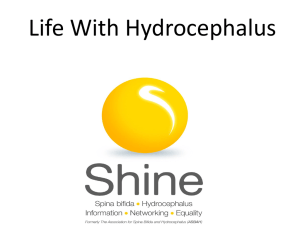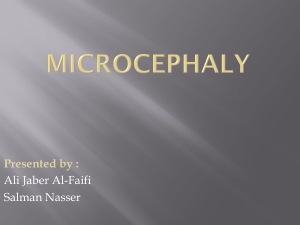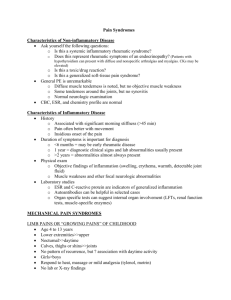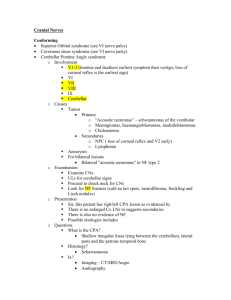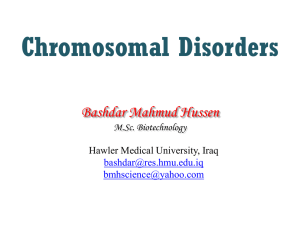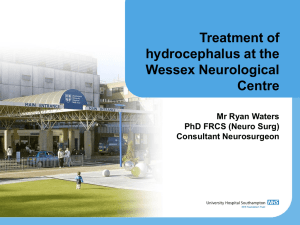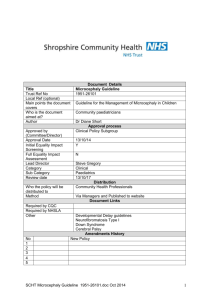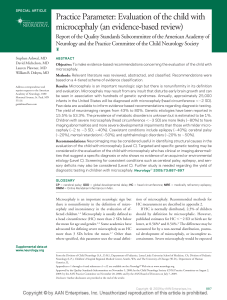Queenie – Congenital Anomalies Part 2
advertisement
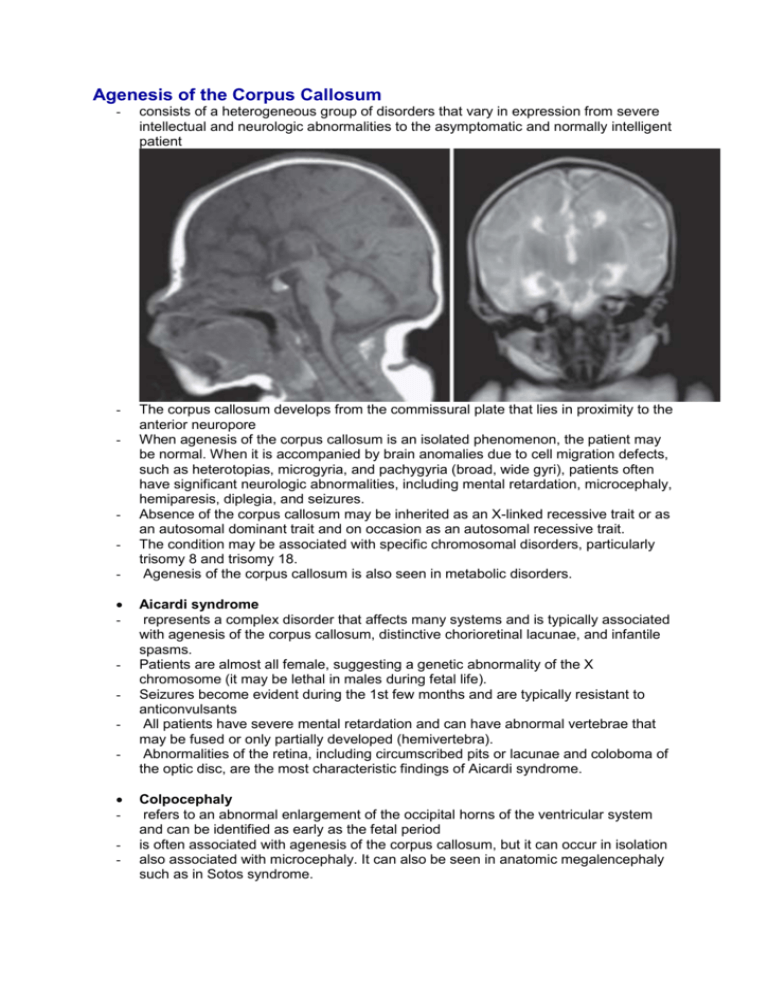
Agenesis of the Corpus Callosum - consists of a heterogeneous group of disorders that vary in expression from severe intellectual and neurologic abnormalities to the asymptomatic and normally intelligent patient - The corpus callosum develops from the commissural plate that lies in proximity to the anterior neuropore When agenesis of the corpus callosum is an isolated phenomenon, the patient may be normal. When it is accompanied by brain anomalies due to cell migration defects, such as heterotopias, microgyria, and pachygyria (broad, wide gyri), patients often have significant neurologic abnormalities, including mental retardation, microcephaly, hemiparesis, diplegia, and seizures. Absence of the corpus callosum may be inherited as an X-linked recessive trait or as an autosomal dominant trait and on occasion as an autosomal recessive trait. The condition may be associated with specific chromosomal disorders, particularly trisomy 8 and trisomy 18. Agenesis of the corpus callosum is also seen in metabolic disorders. - - - Aicardi syndrome represents a complex disorder that affects many systems and is typically associated with agenesis of the corpus callosum, distinctive chorioretinal lacunae, and infantile spasms. Patients are almost all female, suggesting a genetic abnormality of the X chromosome (it may be lethal in males during fetal life). Seizures become evident during the 1st few months and are typically resistant to anticonvulsants All patients have severe mental retardation and can have abnormal vertebrae that may be fused or only partially developed (hemivertebra). Abnormalities of the retina, including circumscribed pits or lacunae and coloboma of the optic disc, are the most characteristic findings of Aicardi syndrome. Colpocephaly refers to an abnormal enlargement of the occipital horns of the ventricular system and can be identified as early as the fetal period is often associated with agenesis of the corpus callosum, but it can occur in isolation also associated with microcephaly. It can also be seen in anatomic megalencephaly such as in Sotos syndrome. HOLOPROSENCEPHALY - is a developmental disorder of the brain that results from defective formation of the prosencephalon and inadequate induction of forebrain structures. - The abnormality is classified into 3 groups: o Alobar is characterized by a single ventricle, an absent falx, and nonseparated deep cerebral nuclei affected children with the alobar type have high mortality rates, but some live for years o semilobar o lobar - - A fourth type, the middle interhemispheric fusion (MIHF) variant or syntelencephaly, involves a segmental area of noncleavage, actually a nonseparation, of the posterior frontal and parietal lobes. Facial abnormalities including cyclopia, synophthalmia, cebocephaly, single nostril, solitary central incisor tooth, and premaxillary agenesis are common in severe cases Alobar holoprosencephaly is characterized by a single ventricle, an absent falx, and nonseparated deep cerebral nuclei. The incidence of holoprosencephaly ranges from 1/5,000 to 1/16,000 The cause of holoprosencephaly is often not identified. There appears to be an association with maternal diabetes. Chromosomal abnormalities, including deletions of chromosomes 7q and 3p, 21q, 2p, 18p, and 13q, as well as trisomy 13 and 18, account for upwards of 50% of all cases Agenesis of the Cranial Nerves and Dysgenesis of the Posterior Fossa CONGENITAL CRANIAL DYSINNERVATION DISORDERS - Absence of the cranial nerves or the corresponding central nuclei has been described in several conditions and includes the optic nerve, congenital ptosis, Marcus Gunn phenomenon (sucking jaw movements causing simultaneous eyelid blinking; this congenital synkinesis results from abnormal innervation of the trigeminal and oculomotor nerves), the trigeminal and auditory nerves, and cranial nerves IX, X, XI, and XII. Increased understanding of these disorders and their genetic causes has led to the term congenital cranial dysinnervation disorders (CCDD). - Optic nerve hypoplasia can occur in isolation or as part of the septo-optic dysplasia complex (De Morsier syndrome). - Septooptic dysplasia can be caused by a mutation in the HESX1 gene. - Möbius syndrome is characterized by bilateral facial weakness, which is often associated with paralysis of the abducens nerve - - Hypoplasia or agenesis of brainstem nuclei as well as absent or decreased numbers of muscle fibers has been reported. Affected infants present in the newborn period with facial weakness, causing feeding difficulties owing to a poor suck The facial appearance of Möbius syndrome has been improved by facial surgery. Duane retraction syndrome characterized by congenital limitation of horizontal globe movement and some globe retraction on attempted adduction and is believed to be the result of abnormal innervations by the oculomotor nerve of the lateral rectus muscle. Less common than Duane retraction syndrome and Möbius syndrome are the group of disorders known as congenital fibrosis of the extraocular muscles (CFEOM). CFEOM is characterized by severe restriction of eye movements and ptosis from abnormal oculomotor and trochlear nerve development and/or from abnormalities of extraocular muscle innervations. BRAINSTEM AND CEREBELLAR DISORDERS - Disorders of the posterior fossa structures include abnormalities of not only the brainstem and cerebellum but also the cerebrospinal fluid spaces. Commonly encountered malformations include Chiari malformation, Dandy-Walker malformation, arachnoid cysts, mega cistern magna, persisting Blake pouch, Joubert syndrome, rhombencephalosynapsis, Lhermitte-Duclos disease, and pontocerebellar hypoplasias. - - - - Chiari malformation the most common malformation of the posterior fossa and hindbrain. It consists of herniation of the cerebellar tonsils though the foramen magnum. Cases are either asymptomatic or symptomatic. When symptoms develop, they often do not do so until late childhood. Symptoms include headaches that are worse with straining and other maneuvers that increase intracranial pressure. Symptoms of brainstem compression such as diplopia, oropharyngeal dysfunction, tinnitus, and vertigo can occur. Obstructive hydrocephalus and/or syringomyelia can also occur. Dandy-Walker malformation is part of a continuum of posterior posterior fossa anomalies that include cystic dilatation of the fourth ventricle, hypoplasia of the cerebellar vermis, hydrocephalus, and an enlarged posterior fossa with elevation of the lateral venous sinuses and the tentorium. The etiology of Dandy-Walker malformation includes chromosomal abnormalities, single gene disorders, and exposure to teratogens. Arachnoid cysts of the posterior fossa can be associated with hydrocephalus. Mega cistern magna is characterized by an enlarged CSF space inferior and dorsal to the cerebellar vermis and when present in isolation may be considered a normal variant. Persisting Blake pouch is a cyst that obstructs the subarachnoid space and is associated with hydrocephalus. Joubert syndrome is an autosomal recessive disorder with significant genetic heterogeneity that is associated with cerebellar vermis hypoplasia and the pontomesencephalic molar tooth sign (a deepening of the interpeduncular fossa with thick and straight superior cerebellar peduncles). - It is associated with hypotonia, ataxia, characteristic breathing abnormalities including episodic apnea and hyperpnea, global developmental delay, nystagmus, strabismus, and oculomotor apraxia. - Rhombencephalosynapsis is an absent or small vermis associated with a nonseparation or fusion of the deep midline cerebellar structures. Ventriculomegaly or hydrocephalus is often seen. Lhermitte- Duclos disease is a dysplastic gangliocytoma of the cerebellum leading to focal enlargement of the cerebellum and macrocephaly, cerebellar signs, and seizures. - - - Pontocerebellar hypoplasias are a group of disorders characterized by impairment of cerebellar and pontine development together with histopathologic features of neuronal death and glial replacement. Clinical features tend to be nonspecific and include hypotonia, feeding difficulties, developmental delay, and breathing difficulties. Causes include: o type I (with features of anterior horn cell involvement) o type II (with extrapyramidal features, seizures, and acquired microcephaly) o Walker-Warburg syndrome o muscle-eye-brain disease o congenital disorders of glycosylation type 1A o mitochondrial cytopathies o teratogen exposure o congenital cytomegalovirus (CMV) infection o 3-methylglutaconic aciduria o PEHO syndrome (progressive encephalopathy with edema, hypsarrhythmia, and optic atrophy) o autosomal recessive cerebellar hypoplasia in the Hutterite population o lissencephaly with cerebellar hypoplasia o other subtypes of pontocerebellar hypoplasia Microcephaly Microcephaly is defined as a head circumference that measures more than 3 standard deviations below the mean for age and sex. This condition is relatively common, particularly among developmentally delayed children. Although there are many causes of microcephaly, abnormalities in neuronal migration during fetal development, including heterotopias of neuronal cells and cytoarchitectural derangements, are often found. Microcephaly may be subdivided into 2 main groups: primary (genetic) microcephaly and secondary (nongenetic) microcephaly. A precise diagnosis is important for genetic counseling and for prediction for future pregnancies. ETIOLOGY - Primary microcephaly refers to a group of conditions that usually have no associated malformations and follow a mendelian pattern of inheritance or are associated with a specific genetic syndrome. Affected infants are usually identified at birth because of a small head circumference. - Primary microcephaly is also associated with at least 7 loci, and 4 single etiologic genes have been identified. It is known as autosomal recessive primary microcephaly - (MCPH) and has autosomal inheritance. Many X-linked causes of microcephaly are caused by gene mutations that lead to severe structural brain malformations such as lissencephaly, and these should be sought on MRI. Secondary microcephaly results from a large number of noxious agents that can affect a fetus in utero or an infant during periods of rapid brain growth, particularly the 1st 2 yr of life. Acquired microcephaly can be seen in conditions such as Rett syndrome and in genetic conditions known also to cause primary microcephaly. CLINICAL MANIFESTATIONS AND DIAGNOSIS - It is important to measure a patient’s head circumference at birth to diagnose microcephaly as early as possible An insult to the brain that occurs later in life, particularly beyond the age of 2 yr, is less likely to produce severe microcephaly. - The head circumference of each parent and sibling should be recorded. - Laboratory investigation of a microcephalic child is determined by the history and physical examination. If the cause of the microcephaly is unknown, the mother’s serum phenylalanine level should be determined. High phenylalanine serum levels in an asymptomatic mother can produce marked brain damage in an otherwise normal nonphenylketonuric infant. - A karyotype and/or array-comparative genomic hybridization (array-CGH) study is obtained if a chromosomal syndrome is suspected or if the child has abnormal facies, short stature, and additional congenital anomalies. - MRI is useful in identifying structural abnormalities of the brain such as lissencephaly, pachygyria, and polymicrogyria, and CT scanning is useful to detect intracerebral calcification TREATMENT Once the cause of microcephaly has been established, the physician must provide accurate and supportive genetic and family counseling. Because many children with microcephaly are also mentally retarded, the physician must assist with placement in an appropriate program that will provide for maximal development of the child. Hydrocephalus Hydrocephalus is not a specific disease; it represents a diverse group of conditions that result from impaired circulation and absorption of CSF or, in rare circumstances, from increased production of CSF by a choroid plexus papilloma. PHYSIOLOGY - The CSF is formed primarily in the ventricular system by the choroid plexus, which is situated in the lateral, 3rd, and 4th ventricles - In a normal child, about 20 mL/hr of CSF is produced. - The total volume of CSF approximates 50 mL in an infant and 150 mL in an adult. - Most of the CSF is extraventricular. - CSF is absorbed primarily by thearachnoid villi through tight junctions of their endothelium by the pressure forces that were noted earlier - Hydrocephalus resulting from obliteration of the subarachnoid cisterns or malfunction of the arachnoid villi is called nonobstructive or communicating hydrocephalus. PATHOPHYSIOLOGY AND ETIOLOGY - Obstructive or noncommunicating hydrocephalus develops most commonly in children because of an abnormality of the aqueduct or a lesion in the 4th ventricle. - - Aqueductal stenosis results from an abnormally narrow aqueduct of Sylvius that is often associated with branching or forking Lesions or malformations of the posterior fossa are prominent causes of hydrocephalus, including posterior fossa brain tumors, Chiari malformation, and the Dandy-Walker syndrome. Nonobstructive or communicating hydrocephalus most commonly follows a subarachnoid hemorrhage, which is usually a result of intraventricular hemorrhage in a premature infant. Blood in the subarachnoid spaces can cause obliteration of the cisterns or arachnoid villi and obstruction of CSF flow CLINICAL MANIFESTATIONS - The clinical presentation of hydrocephalus is variable and depends on many factors, including the age at onset, the nature of the lesion causing obstruction, and the duration and rate of increase of the intracranial pressure (ICP). In an infant, an accelerated rate of enlargement of the head is the most prominent sign - the anterior fontanel is wide open and bulging, and the scalp veins are dilated - The forehead is broad, and the eyes might deviate downward because of impingement of the dilated suprapineal recess on the tectum, producing the settingsun eye sign - In an older child, the cranial sutures are partially closed so that the signs of hydrocephalus may be subtler. Irritability, lethargy, poor appetite, and vomiting are common to both age groups, and headache is a prominent symptom in older patients - Percussion of the skull might produce a cracked pot sound or MacEwen’s sign, indicating separation of the sutures - A foreshortened occiput suggests Chiari malformation, and a prominent occiput suggests the Dandy-Walker malformation - Chiari malformation consists of two major subgroups: o Type I - typically produces symptoms during adolescence or adult life and is usually not associated with hydrocephalus - Patients complain of recurrent headache, neck pain, urinary frequency, and progressive lower extremity spasticity - The deformity consists of displacement of the cerebellar tonsils into the cervical canal - Although the pathogenesis is unknown, a prevailing theory suggests that obstruction of the caudal portion of the 4th ventricle during fetal development is responsible. o type II Chiari malformation - is characterized by progressive hydrocephalus with a myelomeningocele. - this lesion represents an anomaly of the hindbrain, probably owing to a failure of pontine flexure during embryogenesis, and results in elongation of the 4th ventricle and kinking of the brainstem, with displacemen of the inferior vermis, pons, and medulla into the cervical canal - Approximately 10% of type II malformations produce symptoms during infancy, consisting of stridor, weak cry, and apnea, which may be relieved by shunting or by decompression of the posterior fossa - - - Dandy-Walker malformation consists of a cystic expansion of the 4th ventricle in the posterior fossa and midline cerebellar hypoplasia, which results from a developmental failure of the roof of the 4th ventricle during embryogenesis Approximately 90% of patients have hydrocephalus, and a significant number of children have associated anomalies, including agenesis of the posterior cerebellar vermis and corpus callosum The Dandy-Walker malformation is managed by shunting the cystic cavity (and on occasion the ventricles as well) in the presence of hydrocephalus DIAGNOSIS AND DIFFERENTIAL DIAGNOSIS - Examination includes careful inspection, palpation, and auscultation of the skull and spine - The occipitofrontal head circumference is recorded and compared with previous measurements. The size and configuration of the anterior fontanel are noted, and the back is inspected for abnormal midline skin lesions, including tufts of hair, lipoma, or angioma that might suggest spinal dysraphism. - The presence of a prominent forehead or abnormalities in the shape of the occiput can suggest the pathogenesis of the hydrocephalus - The CT scan and/or MRI along with ultrasonography in an infant are the most important studies to identify the specific cause and severity of hydrocephalus - Measurement of parents’ head circumferences is necessary to establish the diagnosis. MEGALENCEPHALY Megalencephaly is an anatomic disorder of brain growth defined as a brain weight:volume ratio >98th percentile for age (or ≥2 standard deviations [SD] above the mean) that is usually accompanied by macrocephaly (an occipitofrontal circumference [OFC] >98th percentile). The most common cause of anatomic megalencephaly is benign familial megalencephaly. This condition is easily diagnosed by careful family history and measurement of the parents’ head circumferences (OFCs). Anatomic megalencephaly is usually apparent at birth, and head growth continues to run parallel to the upper percentiles. Common megalencephalyassociated macrocephaly syndromes include syndromes with prenatal and/or postnatal somatic overgrowth such as Sotos, Simpson-Golabi-Behmel, fragile X, Weaver, M-CMTC, and Bannayan-Ruvalcaba-Riley syndromes and syndromes without somatic overgrowth such as FG, Greig cephalopolysyndactyly, acrocallosal, and Gorlin syndromes. Hypotonia, poor coordination, and speech delay are common. Most children show mental retardation, ranging from mild to severe. HYDRANENCEPHALY - Hydranencephaly may be confused with hydrocephalus. The cerebral hemispheres are absent or represented by membranous sacs with remnants of frontal, temporal, or occipital cortex dispersed over the membrane. The midbrain and brainstem are relatively intact. - The cause is unknown, but bilateral occlusion of the internal carotid arteries during early fetal development would explain most of the pathologic abnormalities. - Affected infants can have a normal or enlarged head circumference at birth that grows at an excessive rate postnatally. TREATMENT - Therapy for hydrocephalus depends on the cause - Medical management, including the use of acetazolamide and furosemide, can provide temporary relief by reducing the rate of CSF production, but long-term results have been disappointing. - The major complications of shunting are occlusion (characterized by headache, papilledema, emesis, mental status changes) and bacterial infection (fever, headache, meningismus), usually due to Staphylococcus epidermidis PROGNOSIS - Prognosis depends on the cause of the dilated ventricles and not on the size of the cortical mantle at the time of operative intervention, except in cases in which the cortical mantle has been severely compressed and stretched. - Hydrocephalic children are at increased risk for various developmental disabilities. - Many children have abnormalities in memory function. - Vision problems are common, including strabismus, visuospatial abnormalities, visual field defects, and optic atrophy with decreased acuity secondary to increased ICP. Craniosynostosis Craniosynostosis is defined as premature closure of the cranial sutures and is classified as primary or secondary. It is associated with varying types of abnormal skull shape. Primary craniosynostosis refers to closure of one or more sutures owing to abnormalities of skull development, whereas secondary craniosynostosis results from failure of brain growth and expansion and is not discussed here. The incidence of primary craniosynostosis approximates 1/2,000 births. The cause is unknown in the majority of children; however, genetic syndromes account for 10-20% of cases. DEVELOPMENT AND ETIOLOGY - The bones of the cranium are well developed by the 5th mo of gestation (frontal, parietal, temporal, and occipital) and are separated by sutures and fontanels. - - The brain grows rapidly in the 1st several years of life and is normally not impeded because of equivalent growth along the suture lines. The cause of craniosynostosis is unknown, but the prevailing hypothesis suggests that abnormal development of the base of the skull creates exaggerated forces on the dura that act to disrupt normal cranial suture development. Genetic factors have been identified for some isolated and for many syndromic causes of craniosynostosis CLINICAL MANIFESTATIONS AND TREATMENT - Most cases of craniosynostosis are evident at birth and are characterized by a skull deformity that is a direct result of premature suture fusion. - Palpation of the suture reveals a prominent bony ridge, and fusion of the suture may be confirmed by plain skull roentgenograms, CT scan or bone scan in ambiguous cases - - - Scaphocephaly Premature closure of the sagittal suture produces a long and narrow skull the most common form of craniosynostosi associated with a prominent occiput, a broad forehead, and a small or absent anterior fontanel The condition is sporadic, is more common in males, and often causes difficulties during labor because of cephalopelvic disproportion does not produce increased ICP or hydrocephalus, and results of neurologic examination of affected patients are normal. Frontal plagiocephaly the next most common form of craniosynostosis and is characterized by unilateral flattening of the forehead, elevation of the ipsilateral orbit and eyebrow, and a prominent ear on the corresponding side more common in females and is the result of premature fusion of a coronal and sphenofrontal suture Occipital plagiocephaly most often a result of positioning during infancy and is more common in an immobile child or a child with a disability, but fusion or sclerosis of the lambdoid suture can cause unilateral occipital flattening and bulging of the ipsilateral frontal bone. Trigonocephaly is a rare form of craniosynostosis caused by premature fusion of the metopic suture. These children have a keel-shaped forehead and hypotelorism and are at risk for associated developmental abnormalities of the forebrain. Milder forms of metopic ridging are more common. Turricephaly refers to a cone-shaped head due to premature fusion of the coronal and often sphenofrontal and frontoethmoidal sutures. The kleeblattschädel deformity is a peculiarly shaped skull that resembles a cloverleaf. Affected children have very prominent temporal bones, and the remainder of the cranium is constricted. Hydrocephalus is a common complication Neurologic complications, including hydrocephalus and increased ICP, are more likely to occur when two or more sutures are prematurely fused The most prevalent genetic disorders associated with craniosynostosis: include Crouzon, Apert, Carpenter, Chotzen, and Pfeiffer syndromes. o Crouzon syndrome - is characterized by premature craniosynostosis and is inherited as an autosomal dominant trait - The shape of the head depends on the timing and order of suture fusion but most often is a compressed back-to-front diameter or brachycephaly due to bilateral closure of the coronal sutures. - The orbits are underdeveloped, and ocular proptosis is prominent. - Hypoplasia of the maxilla and orbital hypertelorism are typical facial features. o Apert syndrome - has many features in common with Crouzon syndrome - is usually a sporadic condition, although autosomal dominant inheritance can occur - It is associated with premature fusion of multiple sutures, including the coronal, sagittal, squamosal, and lambdoid sutures - is characterized by syndactyly of the 2nd, 3rd, and 4th fingers, which may be joined to the thumb and the 5th finger o Carpenter syndrome - is inherited as an autosomal recessive condition, and the many fusions of sutures tend to produce the kleeblattschädel skull deformity - Soft tissue syndactyly of the hands and feet is always present, and mental retardation is common o Chotzen syndrome - characterized by asymmetric craniosynostosis and plagiocephaly - the most prevalent of the genetic syndromes and is inherited as an autosomal dominant\ trait - It is associated with facial asymmetry, ptosis of the eyelids, shortened fingers, and soft tissue syndactyly of the 2nd and 3rd fingers. o Pfeiffer syndrome - is most often associated with turricephaly. - The eyes are prominent and widely spaced, and the thumbs and great toes are short and broad - Most cases appear to be sporadic, but autosomal dominant inheritance has been reported.

